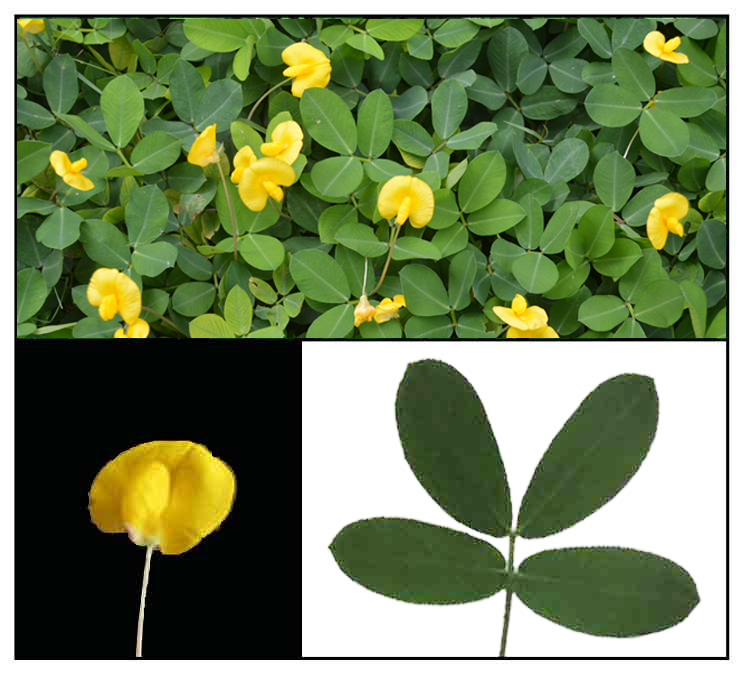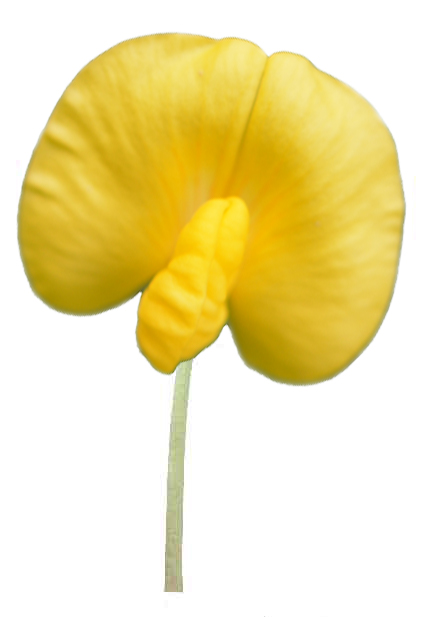 Additional info Additional info
- Named after the Brazilian botanist Geraldo Pinto, who first collected the plant from the locality of Boca do Corrego, municipio de Belmonte in 1954. The species was first described by A. Krapovickas and W. Gregory in 1994. (14)
Botany
Mani-manian is a prostrate, stoloniferous, perennial tropical legume, growing about 8 inches high. Stems grow along the ground and root at the nodes. Leaflets are oval, four on each petiole. Flowers are yellow, borne on short axillary racemes. Flower stalks elongate and grow down into the soil. Fruit is a terminal one-seeded underground pod, light brown, 1 to 1.5 centimeters long, 6 to 8 millimeters in diameter.
Distribution
- Native of central Brazil.
- Spread to Argentina, Australia, and the U.S., later on to the Pacific, Southeast Asia and Central America. (7)
- Planted as ornamental landscaping ground cover.
- Used as alternative cover crop for perennial crops: mango, avocado, coffee, banana, palm oil, pineapple, etc.
- Cultivated
for forage.
 Constituents Constituents
- Leaf consists of 60-70% dry matter digestibility, 13-25% crude protein, and low levels of condensed tannins.
- As forage, yields high nutritional value with 13.-25% crude protein content, 60-70% dry matter digestibility and low levels of condensed tannins.
- Study of essential oil of leaves of perennial Arachis glabrata and edible Arachis hypogaea ranged from 0.0044 % to 0.0061 % (w/w). Major components of three varieties tested were 1-octen-3-ol (40.5-44.8%), ß-linalool (5.0-8.9%) and 4-vinylguaiacol (1.4-8.6%). (13)
Properties
- Seedlings develop quickly, reaching ground cover spread by 6 months through its system of stolons.
- Persistence is attributed to the rooted stolons.
- Little biomass, lacks deep penetrating roots, and takes 4-6 months to establish a ground cover.
- Tolerant of heavy grazing because of persistent stolons.
- A forage plant with slower growth rate serving as cover crop capable of replenishing soil nutrients and physicial properties. (17)
- Studies have suggested antioxidant, anthelmintic, phytoremediative properties.
Parts used
Leaves.
Uses
Edibility
- Flowers are edible; a color ingredient to soups and salads.
Folkloric
- In the Bikol area, leaves crushed and rubbed over insect and centipede bites.
Others
- Fodder: Studies suggest potential as forage plant.
-
Its stoloniferous growth habit, subterranean seed production, high forage quality, and acceptability to grazing cattle are of particular value. (8)
- In Caqueta, Columbia, used by livestock farmers to improve milk yield in cows. In Brazil, valued by farmers as a herbaceous pasture and cover legume. (6)
-
Potential for erosion control
along the exposed benches of city and country roads.
- Used as permanent pasture for intensive grazing systems.
- In the Philippines, used for free range kabir chickens, horses, pigs, tilapia, cat-fish, goats and cows.
Studies
• Feeding System Intensifying Dairy Production:
In Costa Rica's Pacific coastal region, the pasture association Brachiaria decumbens and Arachis pintoi increased daily milk production of Jersey cows.
Although the Jersey cows used in the trial received as supplement a feed concentrate of 14% CP and 2.4 Mcal ME, the beneficial effect of Arachis on milk production could still be observed.
The persistence of A. pintoi during the four years of the evaluation contributed to maintaining production and pasture quality, (4)
• Contribution to Animal Productivity: The perennial peanut (Arachis pintoi) in association with stoloniferous grasses has resulted in productivity increases of 15% milk and 20% beef in experimental plots, with the additional benefit of increasing soil biological activity, notably in the form of higher earthworm populations. It also reduces soil erosion problems and allows the release of on-farm land not suited for grazing for other uses such as reforestation.
(5)
• Anthelmintic / Haemonchus contortus Infective Larvae / Role of Tannins: Study investigated the in vitro anthelmintic activity of five tropical legume plants against Haemonchus contortus infective larvae. At highest concentration, A. pintoi completely inhibited the exsheathment process of H. contortus. The
anthelmintic effect was blocked by the removal of tannin by the addition of polyethylene glycol. (9)
• Phytoremediation / Arsenic Contamination in Coal Ash Dumping Site: Coal ash is a hazardous waste product from coal thermal power plant for electricity generation. CA contains heavy metals which pose an impact on human health and environment. Study investigated the remediation ability of A. pinto. Accumulation of Arsenic was found in root tissue higher than upper parts and remediated up to 11.992%. Results showed the plant had capability to grow and potential to remove As from coal dumping site. (10)
• Antioxidant / Leaves: Study evaluated oven dried and freeze dried ethanol extracts of four common forage legume leaves, viz., Arachis pintoi (Pintoi), C. mucunoides (Calapo), Centrosema pubescens (Centro) and Stylosanthes guanensis (Stylo) for antioxidant activity. All four type of forage legume leaves exhibited strong scavenging effects to DPPH radicals, strong reducing power, and high ß-carotene bleaching inhibitory activities with respect to phenolic content. Arachis pintoi total phenolic content was 7.5 mg GAE/g.
Freeze-dried extracts exhibited excellent antioxidant capacities with higher phenolic content. (12)
• Soil Cover for Vegetable Production: In the Philippines, strip-split design of experimental plots were established in 2007, aimed to look at its effect as cover crop and drip irrigation for the production of commercial vegetables such as Chinese cabbage, cabbage, tomato, bell pepper and carrots. (15)
• Ingredient of Chinese Medicine for Treatment of Mammary Gland Hyperplasia: Invention study reports on the composition of a traditional Chinese medicine for the treatment of hyperplasia of the mammary glands and its preparation method. The raw materials, by weight, are:10-30 parts arachis pintoi, 10-30 parts pratia fruit, 15.-25 parts stenoloma chusana, 10-30 parts prunella vulgaris, 2-8 parts rhizoma cyperi, and 2-8 parts of tangerine seed powder. Pure rice wine is used as guiding drug and water added for decoction. (16)
• Review / ,Strengths and Limitations: Literature review enumerates strengths and limitations of A. pintoi. Limitations are expensive establishment, poor growth in drought conditions, slow establishment, poor germination, insect and pest competition and weed competition. Once established, limitations are reduced. Benefits are listed as: excellence for soil conservation, improvement of soil quality, good source of compost, promotion of tree growth, livestock feed, suppression of weed growth, and a hardy environmental plant. (18)
Availability
- Wildcrafted.
- Cultivated.
- Seedlings in the cybermarket.
|

 Additional info
Additional info Constituents
Constituents


